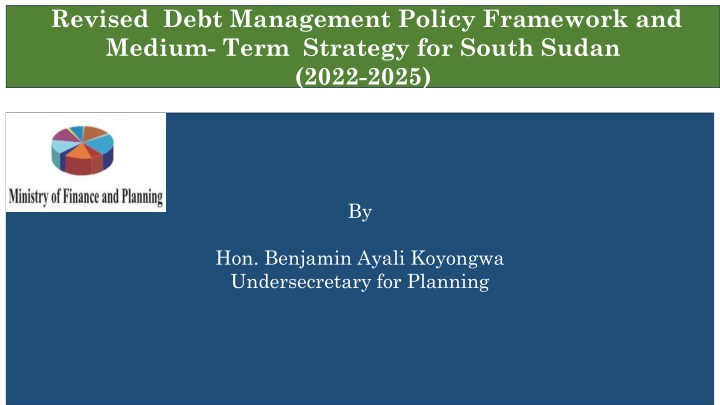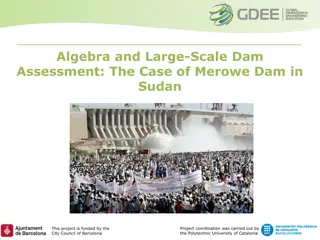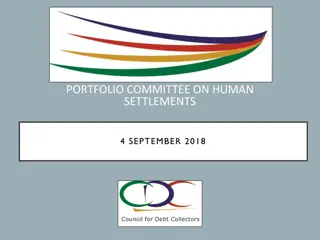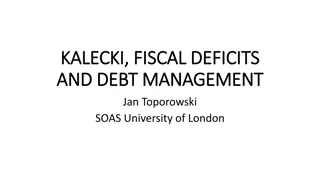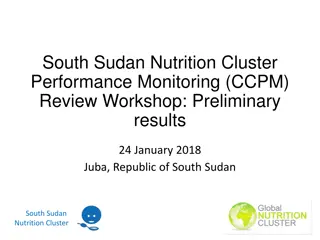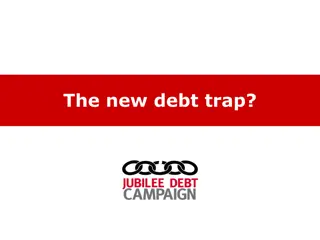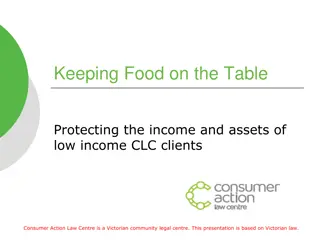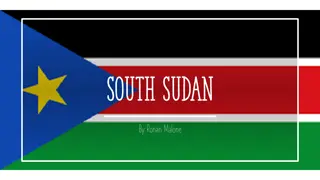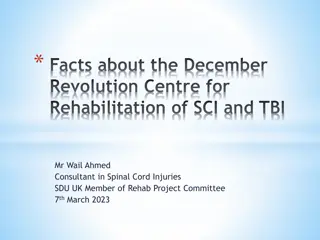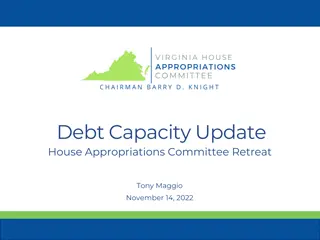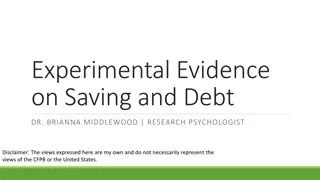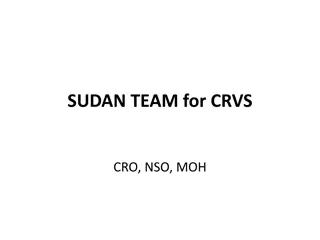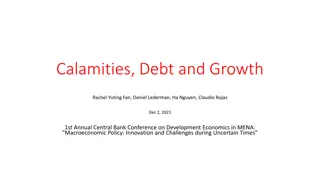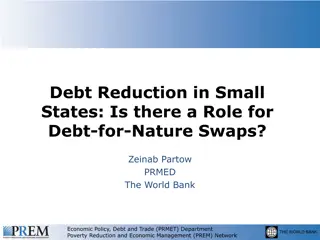Revised Debt Management Policy Framework for Sustainable Development in South Sudan
Debt management is crucial for economic growth in Africa. The Revised National Development Strategy aims to enhance governance, stability, infrastructure development, and social support in South Sudan. The review seeks to update the Debt Management Policy Framework to address future challenges and opportunities.
Download Presentation

Please find below an Image/Link to download the presentation.
The content on the website is provided AS IS for your information and personal use only. It may not be sold, licensed, or shared on other websites without obtaining consent from the author.If you encounter any issues during the download, it is possible that the publisher has removed the file from their server.
You are allowed to download the files provided on this website for personal or commercial use, subject to the condition that they are used lawfully. All files are the property of their respective owners.
The content on the website is provided AS IS for your information and personal use only. It may not be sold, licensed, or shared on other websites without obtaining consent from the author.
E N D
Presentation Transcript
Revised Debt Management Policy Framework and Medium- Term Strategy for South Sudan (2022-2025) By Hon. Benjamin Ayali Koyongwa Undersecretary for Planning
Presentation Outline Introduction Objectives of the Revised National Development Strategy (R-NDS) Overview of the Reviewed Debt Management Policy Framework Elements of the Revised Medium-Term Debt Management Strategy Strategic Options for Debt Management
Introduction Debt Management has become a critical imperative for sustainable economic growth and development in Africa given its vulnerability to fiscal shocks that emanate both from the domestic and international economic crises Most African Countries depend on the oil and commodity export for their budgetary revenues, but lack domestic policy control over their prices and global demand dynamics Fiscal fragilities facing African countries as a result of shocks such as the Global Financial Crises of 2007-2010, Covid-19 pandemic, the Russian- Ukrainian war, internal civil wars/conflicts, natural disasters, and political instability orchestrated elevated borrowing and consequent debt distresses for most African countries
R - NDS ( 2021-2024) and Debt Management in South Sudan: The Nexus Objectives and Goals of the Revised National Development Strategy ( 2021-2024) are as follows; Strengthen Institutions for Transparency, accountability and inclusive Governance Achieve Faster macroeconomic stability and lay foundation for the diversification of the economy Build critical infrastructure for sustainable development, including Roads, energy, public buildings and broad-band Capability Increased support to the social sector for human capital development and protect the vulnerable population to leave no one behind and Mainstream Gender in all development policies and programmes and empower women and youth as drivers of growth and nation building
Purpose of Review of Current Debt Management Policy Framework Debt Management Policy Framework provides policy guidance for the development of the Debt Strategy and its implementation Current Debt Management Policy Framework was designed to cover 2021-2023, thus requiring a new framework for the next medium term The revised Debt Management framework covers 2022-2025 with updated objectives, macroeconomic assumptions, legal and institutional framework and portfolio Risk Management framework
Policy Objectives of the Revised Debt Management Policy Framework Keeping the costs and risks of debt as low as possible, and thereby Keeping debt levels sustainable over the Medium to long term to ensure that debts can be repaid timely, reinforcing fiscal sustainability, macroeconomic stability and sustained growth in the medium to long term The Debt Management Policy framework is hinged on the principles of cost reduction and sustainability, with special emphasis on the debt limits set-out in the PFMAA Act of 2011 ( Debt not exceeding 20% of GDP; Debt Servicing not exceeding 5% of Aggregate Generated Revenue
DMP: Guidelines for Debt Sources and Costs A major objective of Government in the Implementation of the Debt Management Policy Framework is to keep the cost of borrowing within the limits of PFMA Act 2011; Its policy implication are as follows: Therefore, all loans must be procured on Concessional Terms All Loans must have a minimum Grant element of 35% which means that Government will only contract loans with: very low interest Rates ( less than one percent), long grace periods before they begin to be repaid ( over 10 years), and long repayment periods thereafter ( over 30 years) In order to comply with the PFMA Act 2011, the Government will obtain the best possible terms from bilateral lenders, and draw substantially from the Concessional windows, It will avoid all Commercial debts, including credit lines, revolving facilities and bridging loans
DMP: Risk Management Guidelines The Third Objective of the DMP was to minimize debt-related risks, namely: Financial Risks, Refinancing risks, and Contingent Liability Risks To measure the implementation of these risks requires All debts will be borrowed on fixed- rate terms in order to guard against interest rate risks in tandem with borrowing guidelines that maximizes only concessional loans To mitigate Currency risk, all external debts must be borrowed in currencies with which South Sudan keeps its external Reserves To reduce the amount of debt servicing falling due on in any one year at the same time, focus should be on loans with longer maturity periods against shorter maturity periods To adopt a highly prudent policy aimed at reducing fiscal risks associated with contingent liabilities, Government will not guarantee borrowing by entities, no on- lending, and avoid all off-budget arrangements such as PPPs In line with Oil revenue Act, Government will not use any oil or other measures as collateral, guarantees or repayment methods
Issues considered in the Review of Current Debt Management Policy Framework PFMA Act 2011 legislated debt limits of 20% of GDP and 5 % of Debt Servicing understates the debt carrying capacity of the economy to borrow- This section of the Act needs to be amended It is not possible to borrow all debts at fixed interest rates given that sources for concessional loans remain limited and commercial loans offer opportunity to bridge the gap Mitigating Currency Risk: is to ensure that all external debts are contracted in currency in which South Sudan keeps its reserves. Contingent liabilities and off-budget arrangements cannot be completely avoided, but can be controlled through regulations, given that government needs to encourage state led industrialization.
Macroeconomic Goals of Government in 2021/2022 Fiscal Year Continue with the implementation of the eleven priorities of the Public Financial Management Reform Strategy Achieve Economic Growth of at least 1 percent from the -5.4 percent in FY 2020/2021 Reduce Inflation from 22. 8 percent in FY 2020/2021 to 16.3 percent in FY 2021/2022 Diversify the economy by making Agriculture the engine of inclusive growth and sustainable livelihood for the poor and vulnerable household, and Allocate more resources for implementation of the R- ARCSS and for Human and Physical capital formation
Fiscal Policy Goals of Government in 2021/2022 Fiscal Year Establishment of Single Treasury Account ( TSA) Operationalization of the Cash Management Committee ( CMC) which will provide cash on quarterly basis and in advance to all spending Units Full Implementation of the Biometric System for all the public sector employees who will be required to open bank accounts with the commercial banks Establishment of Public Procurement and Asset Disposable Authority ( PPADA Review and verification of all the arrears on goods and services provided by the private sector to various government agencies Public budgetary and economic Review Continue to improve on collection of non-oil Review Maintain effective coordination between monetary and fiscal policy
Debt and Aid Policies For FY 2021/2022 Long term debt Management objectives was to raise adequate levels of financing at minimum cost and risk Pursue Strategies to ensure that the National Public Debt is maintained at sustainable levels over the medium to long term Avoid borrowing money from the domestic market during the 2021/2022 Fiscal Year, including borrowing from the Bank of South Sudan On the external debt front, strategy will be to source external funds, when required, on concessionality terms and ensure that any new borrowings does not undermine debt sustainability We will also intensify efforts to consolidate the legal framework governing the contraction of debt and its management
Percentage Distribution and Features of External Financing Sources As at December 31, 2020 As at December 31.2022 % of External Debt 4.08 % of External Debt Interest Rate Grace Period Interest Rate Grace Period S/N Creditor Tenor Concessionality S/NCreditor Tenor Concessionality 1. IDA 4.08 1.05 9 39 High 1. IDA 1.05 9 39 High 1. ADF 11.06 0.08 10 40 High 2. ADF 0.92 0.75 10 40 High 1. IMF 0.14 N/A NA N/A High 1. China EXIM 6.37 2.0 5 20 Medium 3. China EXIM 7.66 2.00 5 20 Medium 1. Afreximbank 1 9.58 Variable Nil 5 Nil 4. Afreximbank 23.48 Variable Nil 4 Nil 1. Afroeximbank 2 0.44 Variable 1yr 3 Nil 1. Afroeximbank 3 7.18 Variable Iyr - Nil 5. Qatar 34.19 Nil Nil 1 Nil 1. Qatar 6.27 6.5 Nil 1 Nil 6. Sudan (TFA) 24.25 Nil Nil 4 Nil 1. NASDEC 35.87 Nil Nil 4 Nil 1. Sahara 21.85 N/A N/A N/A N/A 7. Sahara 5.42 N/A N/A N/A N/A 1. Trade Bank 2.57 Variable Nil 2 Nil 8. Trinity 0.0 Variable Nil 2 Nil 1. National Bank 0.82 8 - 1yr Nil 1. Bank of SS 100 N/A NA NA NA Total 100 Total 100
Percentage Distribution of DEBT SERVICE Obligations Percentage Distribution of DEBT SERVICE Obligations of External Loans of External Loans Financial Year 2021/2022 Financial Year 2022/2023 S/N Creditor Name Principal in USD( millions) 0 0 0 15 15 246.98 63.65 183.33 96.0 36.0 60.0 357.98 Interest in USD( Millions) 0.77 0.66 0.11 2.0 2.0 45.79 43.44 2.35 18.4 12.4 6 66.96 Total in USD ( Millions) 0.77 0.66 0.11 17 17 292.77 107.09 185.68 114.4 48.4 66 424.94 % of Total 0.81 3.00 67.89 25.92 100 S/N Creditor Name Principal in USD( millions) 0.2 0.2 0 9.99 9.99 246.98 63.65 183.33 96.0 36.0 60.0 351.17 Interest in USD( Millions) 0.77 0.66 0.11 2.9 2.9 45.79 43.44 2.35 18.4 12.4 6 67.86 Total in USD ( Millions) 0.97 0.86 0.11 12.89 12.89 292.77 107.09 185.68 114.4 48.4 66 421.03 % of Total 0.81 3.03 68.53 26.17 100 A. 1 2 B 3 C 4 5 D 6 7 MULTILATERALs IDA AFDB BILATERALS China COMMERCIALs QNB AFROEXIM OIL ADVANCES SAHARA ENERGY NASDEC TOTAL( USDm) A. 1 2 B 3 C 4 5 D 6 7 MULTILATERALs IDA AFDB BILATERALS China COMMERCIALs QNB AFROEXIM OIL ADVANCES SAHARA ENERGY NASDEC TOTAL( USDm)
Imperatives for Formulation of Alternative Debt Management Strategy Based on Analysis of the Existing Debt Financing Policy and Public Debt Portfolio performance as at December 31,2022, we therefore observe as follows: Though R-NDS (2021-2024) provides for borrowing to finance its developmental projects and programmes, current debt portfolio performance numbers does not warrant such continued borrowing Analysis so far suggest that South Sudan is still under Debt Distress as its current debt servicing burden and weak debt carrying capacity suggests The country seem to be saturating its concessional financing window with the addition of IMF ( or is it SDR) loan which narrowed the space to further increase borrowing in the Concessional window Resort to Oil related borrowing on commercial terms and oil advances is dramatically increasing its debt servicing burden, especially when oil revenues are not increasing in tandem Bank of South Sudan remains the only window for domestic borrowing, the policy to reduce monetary financing makes good case for achieving Monetary policy goals, but the pressure to borrow increase ways and means will remain until domestic market for debt is developed
DEBT STRATEGY 1: Baseline Existing Debt Financing Policy Debt Management Policy remains even when Debt Portfolio performance suggests change Main Sources of borrowing must come from Concessional and bilateral loan sources as contained in the PFMA Act 2011, but the financing sources from such windows prove inadequate to address the financing gap Increased borrowing from commercial and Oil advances has diminished the effect of the above debt financing Policy and might render it unsustainable and ineffective as a debt financing option going forward Caping borrowing to 20% of GDP and 5% of Debt Services is no longer realistic in the face of oil price developments and mounting fiscal pressure to pay attention to development issues Although there was concerted effort in FY 2021/2022 to reduce borrowing from Bank of South Sudan, such a policy is not sustainable without developing a robust domestic Market for debt.
DEBT STRATEGY 2: Debt Relief Debt Rescheduling of Commercial Loans In the context of current Debt Portfolio performance, the suggested Debt Strategy would be to seek for debt relief or restructuring especially of Commercial loans: However, there must be some notable condition precedent for that to happen Concerted effort must be made to change the image of South Sudan as a fragile, conflict prone state to a stable democracy will imbue confidence in the creditors to keep their borrowing windows open to the country Current high level commitment to the Revitalized Agreement for Resolution of Conflict in South Sudan ( R- ARCSS) should produce a peaceful transition to new government in the next elections to signal to the international creditor community that South Sudan is ready for business and therefore should be assisted to reschedule their debts. Gradual transitioning of current Debt Management Unit ( DMU) into a Debt Management Agency in the medium to long term of 3-5 years from now will send a strong signal to the global capital markets that the institutional environment for debt procurement and effective management now exists in South Sudan
Table 1: Projected Costs and Risk Indicators After Achieving Rescheduling of Debts Risk Indicators External Debt 2,0505.21 44.23 Domestic Debt 426.91 11.32 Total Debt 2,477.05 55.55 GSS s Total Public Debt (US$ Million) NPV of Debt as a % of GDP Weighted Average Cost of Debt (%) Average Time-to-Refixing (Yrs.) Fixed Rate Debt (% of Total) Average Time-to-Maturity (Yrs.) Debt Maturing within 1 yr. (% of Total) Foreign Exchange Risk FX Debt (% of Reserves) 6.17 10.08 8.02 3.12 3.60 3.19 Interest Rate Risk 13.66 100.00 32.52 5.17 3.40 4.24 Refinancing Risk 19.42 20.00 19.34 FX Debt (% of Total) 78.36 4,627.32
Preferred Debt Strategy 3: Combination of Debt Rescheduling and Development of Domestic Debt Market The preferred Debt Strategy still remains a combination of the Debt relief by way of rescheduling and the development of the domestic debt Market The debt rescheduling will avert some Risks such as interest rate risk for fixed interest rate loans which will increase the time to refixing of the loans and give some headroom for the country to gradually pay off the loans Debt rescheduling will also lengthen the average time to maturity of some of the commercial loans with heavy debt servicing burden and the other debts with maturing time of one year with the consequences of their servicing on the current revenue The development of the domestic debt market can be achieved first by recapitalizing some of the domestic banks or consolidation them to build enough capital buffer to be able to take up bond and other security offers from government Domestic debt market will also benefit from establishment of a robust Debt Management Agency that will have the expertise to issue government debt and manage same in the market Development of the domestic market will provide alternative financing for government fiscal deficits and drastically reduce dependence on Monetary financing from the Bank of South Sudan
Public Debt Management Strategy and Targets by end -2025 Debt Management Targets for the period 2022-2025: Portfolio Composition Domestic: External Domestic Debt Mix: Long: Short Risks Refinancing Debt maturing in 1 year as % of total debt Average Time to Maturity (Years) Interest rate Variable Rate Debt as % of Total Debt In addition, the following fiscal sustainability ratios will also be monitored. Fiscal Sustainability Total Debt as % of GDP Solvency Indicators % of GDP Domestic Debt as % of GDP Current Levels 23:77 0:100 2022-2025 Target Max.70: Min.30 Min. 75: Max. 25 73% Max. 20% 2.36 years Min. 10 years 67.48% Less than 10% 54.63 35% External Debt as 42.21 12.42 30% Not Applicable*
